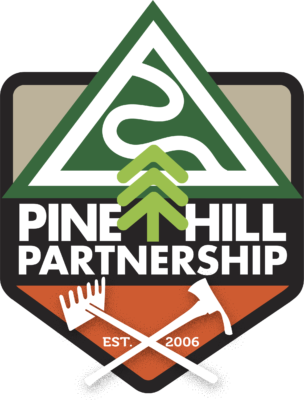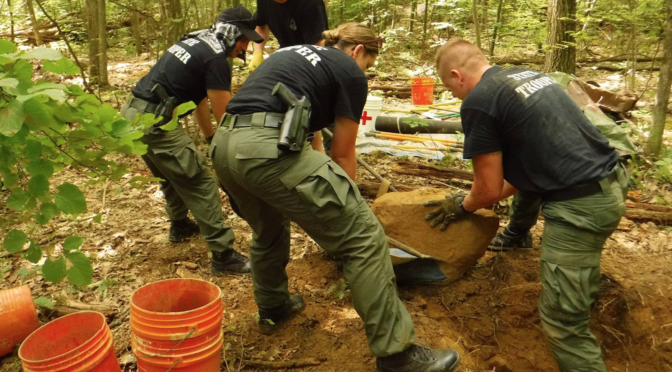Unique Trail Character and User Experience
Pine Hill Park is unlike many other mountain bike trails systems in North America, and visitors from in- and out-of-state travel to the park to experience our unique trails. This unique character includes hand-made single-track, berms, drainages, and playful bridges through the Park’s hardwoods and quartzite boulders and ridges. Since trail-building began in 2003, trail builders have worked to maintain this unique user experience. As of 2019, Pine Hill Park’s 325 acres are almost at capacity for trails. But anyone with ideas to improve sections of trail is welcome to make a plan, then present the plan for approval to the land owner and steward.

Land Owner and Steward
Pine Hill Park is owned by Rutland City. Pine Hill Partnership is the land steward in cooperation with the Rutland City Recreation and Parks Department. Pine Hill Partnership manages all building and maintenance of the Pine Hill Park trail system. Permission to build or alter the trail system must be obtained from Rutland Recreation and Pine Hill Partnership.
The Carriage Trail and Redfield Trails are on private property. Hikers and mountain bikers are graciously allowed to use these trails with landowner permission. Please do not create new trails or features, or make improvements on these trail systems.
New trail builders must first participate in trail maintenance with a local veteran trail builder.
Backlogged trail maintenance must be addressed before new construction is allowed. For example, new black-level features will only be allowed after any black-level trail in disrepair is first fixed. Modifications to blue and green level trails are effectively off limits to new builders unless approved by Rutland Recreation and the PHP board of directors. Exceptions are made for re-routing due to environmental and erosional issues and the building of features by an appointed or paid trail crew.
Potential trail builders must:
- Be members of Pine Hill Partnership.
- Seek permission from the land steward (Pine Hill Partnership) and Rutland Recreation.
- Have a written plan (can be in email) that includes information about :
a. Reasons trail improvement is needed.
b. Trail grade (trail steepness should not exceed half the grade or steepness of the hillside and overall grade should be 10 percent or less).
c. Trail drainage (trails should be sloped to drain properly and banked corners should have inside ditches that are ‘rip-rapped’ with small stones, etc.).
d. Trail coverage (any new or refurbished trail must have leaves covering the new dirt).
e. Intersections with existing trails; any trail re-route or new trail must come into an existing intersection, not create a new one.
f. Signage (must match current signs in the park).
g. Expected usage.
h. Skill level required to ride the new trail.
i. Construction timeline and plan.
j. Maintenance plan.
k. Materials needed and cost.
l. How the character of Pine Hill Park is preserved.
m. How the trail does not require a downgrade or upgrade to the originally intended skill level (Black, Blue, and Green). - Build trails for multiple users (including pedestrians), not a select few.
- Build features within the physical character and style of the current trail system.
- Build features with landings, take-off points, and/or transitions for jumps at least one bike length long. There must be sufficient distance between obstacles and features for riders to recover and regain balance on their bikes.
- Cover dirt borrows with fallen logs and leaves. Of note, the quartz-rich soil on Pine Hill is limited for trail building.
- Build according to IMBA best practices (see below).
- Limit use of excavating machines. No machine-built flow trails are allowed.
Additionally, an existing trail may not be modified such that it removes or introduces features that substantially alter the character of the trail.
Regarding trail maintenance, autumn leaves will not be removed from park trails. The trails in Pine Hill Park benefit from leaving autumn leaves on the single-track pathways. Also, trees will not be removed if they provide pinch points to prevent motorized vehicles from gaining access to the trail systems and/or help riders control speed.
IMBA Best Practices
Build according to established trail and feature guidelines provided by the International Mountain Bike Association (IMBA). Trails, natural features (such as steep rock rolls and rock drops) and man-made features (such as jumps and berms) must be durable, predictable, and designed to moderate the risk of injury when riders fail to negotiate them properly. The preference in all cases is to use natural materials found within the park.
Emphasize skill instead of consequence. Challenging features don’t have to be overly dangerous. There is risk inherent in all styles of mountain biking, but appropriate design removes unnecessary dangers.
Provide options and “ride-arounds.” When building features, offer easier options and routes that avoid the feature whenever possible. Build features and challenges that are appropriate for the skill level of the trail. Provide opportunities for a variety of skill levels.
Build skill “gateway filters.” Entrances to difficult trails and features should be made challenging. These gateways will cause inexperienced riders to avoid the trail or dismount early on a feature, before the feature is high above the ground where the rider is more likely to be injured should a fall occur. This will reduce the risk of less skilled riders attempting a trail or feature that is beyond their ability.
Provide appropriate fall zones. Clear hazards from areas where riders are likely to land from a fall.
Build choke points. Choke points are narrow, difficult, and very visible features that will slow riders down before a higher risk area. Choke points are built close to the ground with safe fall zones in case of a fall.
Design proper flow into trails. Avoid abrupt transitions from open and flowing to tight and technical.
Eliminate surprise. Provide clear site lines and don’t surprise trail users with unexpected technical trail features. Challenging trails should be properly signed. Make sure that riders can see technically challenging trail sections well in advance. The most difficult section of a feature should be made visible from the entry. By placing the difficult section in view, the rider can make an informed decision before they may get into difficulty with a feature that may be beyond their ability.
Mark trails and features according to established sign standards. Trailhead signs can provide general information about the trails and features, but their highest priority is to alert riders to the difficulty level and technical challenges on the trail ahead.
Eliminate hazards or identify them with signs. Dangerous rocks or stumps in higher speed zones or potential fall zones should be removed. Potential hazards exist that can’t be removed, such as a nearby cliff or fence. If the trail can’t be routed away from the hazard, then choke points should be implemented to control speed and the hazard visibly signed.

